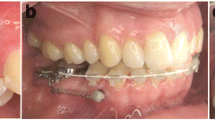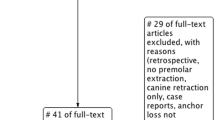Abstract
Objectives
Orthodontic mini-implants (OMIs) are a reliable method to provide temporary orthodontic anchorage. We hypothesized that there is an optimal insertion torque (<10 Ncm) that can be used to ensure the success of self-drilling OMIs in the paramedian region.
Patients and methods
Included were 40 (26 females, 14 males) consecutive patients requiring palatal skeletal anchorage. Mean age was 17.3 years (range 11.0–44.6 years) for female patients and 15.7 years (range 10.6–36.9 years) for male patients. A total of 22 patients received a Beneslider according to Wilmes for the distalization of maxillary first molars, 10 patients received a Mesialslider for the mesialization of maxillary first molars, and 8 patients received a bone-borne rapid palatal expansion (RPE) appliance. Torque values of 10–15 Ncm were recorded in 46.3% of the OMIs and 15–20 Ncm in 35% of OMIs. OMIs that endured the orthodontic force applied for ≥6 months were considered as success.
Results
The overall success rate was 98.8%. No significant differences were found between insertion torque values with respect to the right and left sides, Jarabak’s ratio, facial axis, and Frankfort to mandibular plane angle. There were no significant differences in the OMIs insertion torques with regard to the different appliances. No association was found between insertion torque and vertical skeletal morphology.
Conclusion
With an overall success rate of 98.8%, the study hypothesis that greater insertion torque (>10 Ncm) will decrease the success rate and increase palatal OMI failure was rejected.
Zusammenfassung
Zielsetzung
Kieferorthopädische Mini-Implantate (OMIs) stellen eine verlässliche Methode dar, um eine temporäre kieferorthopädische Verankerung zu gewährleisten. Wir stellten die Hypothese auf, dass es für paramedian inserierte selbstbohrende OMIs ein optimales Insertionsdrehmoment (<10 Ncm) gibt.
Patienten und Methoden
Vierzig (26 w, 14 m) konsekutive Patienten, bei denen eine skelettale Verankerung im Gaumen erforderlich war, wurden in die Studie aufgenommen. Das Durchschnittsalter lag bei 17,3 (11,0–44,6) Jahren für die weiblichen bzw. 15,7 (10,6–36,9) für die männlichen Patienten. Insgesamt 22 Patienten erhielten einen Beneslider nach Wilmes zur Distalisation der ersten Oberkiefermolaren, 10 erhielten einen Mesialslider zur Mesialisation der ersten Oberkiefermolaren und 8 eine knöchern verankerte Apparatur zur forcierten Gaumennahterweiterung (GNE). Bei 46,3% der OMIs wurden Drehmomente von 10–15 Ncm registriert und bei 35% Werte von 15–20 Ncm. Als Erfolg wurden die OMIs gewertet, die der für ≥6 Monate applizierten kieferorthopädischen Kraft standhielten.
Ergebnisse
Insgesamt lag die Erfolgsquote bei 98,6%. Er ergaben sich keine statistisch signifikanten Unterschiede zwischen den Drehmomenten in Bezug auf den Jarabak-Index, den Gesichtsindex oder den FMPA (Winkel zwischen Frankfurter Horizontalen und Mandibularebene, FH-MP), auch nicht zwischen den beiden Seiten. Es ließen sich keine signifikanten Unterschiede zwischen OMI-Drehmoment-Werten im Hinblick auf die verschiedenen Apparaturen feststellen. Zwischen Insertionsdrehmoment und vertikaler skelettaler Morphologie fand sich ebenfalls kein Zusammenhang.
Schlussfolgerung
Bei einer Erfolgsquote von insgesamt 98,8% wurde die Hypothese, dass höhere Drehmomente bei der Insertion(>10 Ncm) die Erfolgsrate verringern und die Versagensquote palatinaler OMIs erhöhen, verworfen.



Similar content being viewed by others
References
Baumgaertel S (2014) Temporary skeletal anchorage devices: the case for miniscrews. Am J Orthod Dentofacial Orthop 145:560
Bernhart T, Vollgruber A, Gahleitner A, Dortbudak O, Haas R (2000) Alternative to the median region of the palate for placement of an orthodontic implant. Clin Oral Implants Res 11:595–601
Cehreli S, Arman-Ozcirpici A (2012) Primary stability and histomorphometric bone-implant contact of self-drilling and self-tapping orthodontic microimplants. Am J Orthod Dentofacial Orthop 141:187–195
Chaddad K, Ferreira AF, Geurs N, Reddy MS (2008) Influence of surface characteristics on survival rates of mini-implants. Angle Orthod 78:107–113
Dahlberg G (1940) Statistical methods for medical and biological students. Interscience Publications, New York
Di Leonardo B, Ludwig B, Glasl B, Hourfar J, Mura R (2016) BRÖLEX—Eine rein knochengetragene Expansionsapparatur. Vorstellung und erste klinische Erfahrungen. Kieferorthopädie 30:149–152
Horner KA, Behrents RG, Kim KB, Buschang PH (2012) Cortical bone and ridge thickness of hyperdivergent and hypodivergent adults. Am J Orthod Dentofacial Orthop 142:170–178
Hosein YK, Dixon SJ, Rizkalla AS, Tassi A (2017) A comparison of the mechanical measures used for assessing orthodontic mini-implant stability. Implant Dent 26:225–231
Hourfar J, Ludwig B, Bister D, Braun A, Kanavakis G (2015) The most distal palatal ruga for placement of orthodontic mini-implants. Eur J Orthod 37:373–378
Hourfar J, Kanavakis G, Bister D, Schätzle M, Awad L, Nienkemper M, Goldbecher C, Ludwig B (2015) Three dimensional anatomical exploration of the anterior hard palate at the level of the third ruga for the placement of mini-implants - a cone-beam CT study. Eur J Orthod 37:589–595
Hourfar J, Bister D, Lux CJ, Al-Tamimi B, Ludwig B (2017) Anatomic landmarks and availability of bone for placement of orthodontic mini-implants for normal and short maxillary body lengths. Am J Orthod Dentofacial Orthop 151:878–886
Karagkiolidou A, Ludwig B, Pazera P, Gkantidis N, Pandis N, Katsaros C (2013) Survival of palatal miniscrews used for orthodontic appliance anchorage: a retrospective cohort study. Am J Orthod Dentofacial Orthop 143:767–772
Kim YH, Yang SM, Kim S, Lee JY, Kim KE, Gianelly AA, Kyung SH (2010) Midpalatal miniscrews for orthodontic anchorage: factors affecting clinical success. Am J Orthod Dentofacial Orthop 137:66–72
Lim HJ, Eun CS, Cho JH, Lee KH, Hwang HS (2009) Factors associated with initial stability of miniscrews for orthodontic treatment. Am J Orthod Dentofacial Orthop 136:236–242
Liou EJ, Pai BC, Lin JC (2004) Do miniscrews remain stationary under orthodontic forces? Am J Orthod Dentofacial Orthop 126:42–47
Manni A, Cozzani M, Tamborrino F, De Rinaldis S, Menini A (2011) Factors influencing the stability of miniscrews. A retrospective study on 300 miniscrews. Eur J Orthod 33:388–395
Maya RR, Pinzan-Vercelino CR, Gurgel JA (2016) Effect of vertical placement angle on the insertion torque of mini-implants in human alveolar bone. Dental Press J Orthod 21:47–52
Melo AC, Andrighetto AR, Hirt SD, Bongiolo AL, Silva SU, Silva MA (2016) Risk factors associated with the failure of miniscrews—a ten-year cross sectional study. Braz Oral Res 30:e124
Meursinge Reynders RA, Ronchi L, Ladu L, van Etten-Jamaludin F, Bipat S (2012) Insertion torque and success of orthodontic mini-implants: a systematic review. Am J Orthod Dentofacial Orthop 142:596–614
Miyawaki S, Koyama I, Inoue M, Mishima K, Sugahara T, Takano-Yamamoto T (2003) Factors associated with the stability of titanium screws placed in the posterior region for orthodontic anchorage. Am J Orthod Dentofacial Orthop 124:373–378
Motoyoshi M, Hirabayashi M, Uemura M, Shimizu N (2006) Recommended placement torque when tightening an orthodontic mini-implant. Clin Oral Implants Res 17:109–114
Motoyoshi M, Inaba M, Ono A, Ueno S, Shimizu N (2009) The effect of cortical bone thickness on the stability of orthodontic mini-implants and on the stress distribution in surrounding bone. Int J Oral Maxillofac Surg 38:13–18
Nguyen MV, Codrington J, Fletcher L, Dreyer CW, Sampson WJ (2018) The influence of miniscrew insertion torque. Eur J Orthod 40:37-44
Nienkemper M, Pauls A, Ludwig B, Drescher D (2015) Stability of paramedian inserted palatal mini-implants at the initial healing period: a controlled clinical study. Clin Oral Implants Res 26:870–875
Nienkemper M, Wilmes B, Pauls A, Drescher D (2012) Multipurpose use of orthodontic mini-implants to achieve different treatment goals. J Orofac Orthop 73:467–476
Nienkemper M, Wilmes B, Pauls A, Drescher D (2014) Mini-implant stability at the initial healing period: a clinical pilot study. Angle Orthod 84:127–133
Nienkemper M, Handschel J, Drescher D (2014) Systematic review of mini-implant displacement under orthodontic loading. Int J Oral Sci 6:1–6
Papadopoulos MA, Tarawneh F (2007) The use of miniscrew implants for temporary skeletal anchorage in orthodontics: a comprehensive review. Oral Surg Oral Med Oral Pathol Oral Radiol Endod 103:21
Papadopoulos MA, Papageorgiou SN, Zogakis IP (2011) Clinical effectiveness of orthodontic miniscrew implants: a meta-analysis. J Dent Res 90:969–976
Papageorgiou SN, Zogakis IP, Papadopoulos MA (2012) Failure rates and associated risk factors of orthodontic miniscrew implants: a meta-analysis. Am J Orthod Dentofacial Orthop 142:577–595
Sander C, Huffmeier S, Sander FM, Sander FG (2006) Initial results regarding force exertion during rapid maxillary expansion in children. J Orofac Orthop 67:19–26
Suzuki EY, Suzuki B (2011) Placement and removal torque values of orthodontic miniscrew implants. Am J Orthod Dentofacial Orthop 139:669–678
Suzuki M, Deguchi T, Watanabe H, Seiryu M, Iikubo M, Sasano T, Fujiyama K, Takano-Yamamoto T (2013) Evaluation of optimal length and insertion torque for miniscrews. Am J Orthod Dentofacial Orthop 144:251–259
Tepedino M, Masedu F, Chimenti C (2017) Comparative evaluation of insertion torque and mechanical stability for self-tapping and self-drilling orthodontic miniscrews—an in vitro study. Head Face Med 13:17–143
Topouzelis N, Tsaousoglou P (2012) Clinical factors correlated with the success rate of miniscrews in orthodontic treatment. Int J Oral Sci 4:38–44
Tsai CC, Chang HP, Pan CY, Chou ST, Tseng YC (2016) A prospective study of factors associated with orthodontic mini-implant survival. J Oral Sci 58:515–521
Wilmes B, Ludwig B, Vasudavan S, Nienkemper M, Drescher D (2016) The T‑zone: median vs. paramedian insertion of palatal mini-implants. J Clin Orthod 50:543–551
Wilmes B, Nienkemper M, Drescher D (2010) Application and effectiveness of a mini-implant- and tooth-borne rapid palatal expansion device: the hybrid hyrax. World J Orthod 11:323–330
Wilmes B, Su YY, Drescher D (2008) Insertion angle impact on primary stability of orthodontic mini-implants. Angle Orthod 78:1065–1070
Wilmes B, Nienkemper M, Nanda R, Lubberink G, Drescher D (2013) Palatally anchored maxillary molar mesialization using the mesialslider. J Clin Orthod 47:172–179
Wilmes B, Drescher D (2010) Application and effectiveness of the Beneslider: a device to move molars distally. World J Orthod 11:331–340
Wilmes B, Ottenstreuer S, Su YY, Drescher D (2008) Impact of implant design on primary stability of orthodontic mini-implants. J Orofac Orthop 69:42–50
Winsauer H, Vlachojannis J, Winsauer C, Ludwig B, Walter A (2013) A bone-borne appliance for rapid maxillary expansion. J Clin Orthod 47:375–381
Winsauer H, Vlachojannis C, Bumann A, Vlachojannis J, Chrubasik S (2014) Paramedian vertical palatal bone height for mini-implant insertion: a systematic review. Eur J Orthod 36:541–549
Yamaguchi M, Inami T, Ito K, Kasai K, Tanimoto Y (2012) Mini-implants in the anchorage armamentarium: new paradigms in the orthodontics. Int J Biomater 2012:394121
Author information
Authors and Affiliations
Corresponding author
Ethics declarations
Conflict of interest
B. Di Leonardo, B. Ludwig, J.A. Lisson, L. Contardo, R. Mura and J. Hourfar declare that they have no competing interests.
Ethical standards
Ethical approval for this retrospective study was obtained from the institutional review board. For this type of study formal consent is not required.
Rights and permissions
About this article
Cite this article
Di Leonardo, B., Ludwig, B., Lisson, J.A. et al. Insertion torque values and success rates for paramedian insertion of orthodontic mini-implants. J Orofac Orthop 79, 109–115 (2018). https://doi.org/10.1007/s00056-018-0120-x
Received:
Accepted:
Published:
Issue Date:
DOI: https://doi.org/10.1007/s00056-018-0120-x




